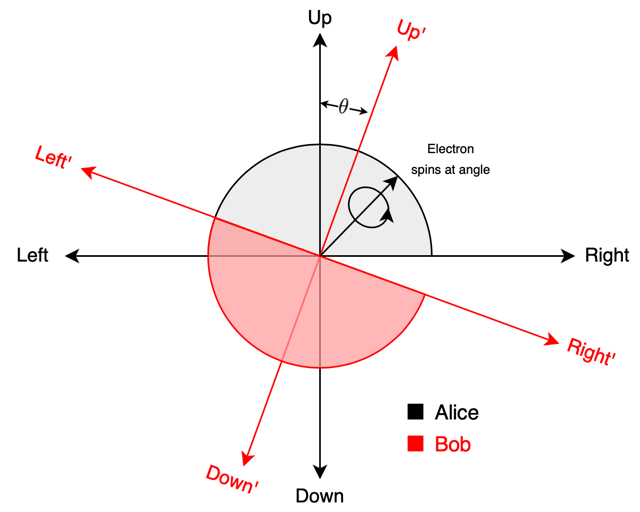I asked this question a while ago, wherein I ask for more information about how the probabilities are calculated when photons spins are measured at different angles. The equation is:
$$\frac12\sin^2 (20^\circ)$$
Now, you can stop reading my post now and read the article I linked to in my other question, or I could try to do it justice by explaining it here:
We know based on the above formula that if you measure the photons with measuring devices at certain angles relative to each other, or to some base line "0degree" angle, you'll get these results:
same angle: 100% anti-correlation, 0% same results
0∘ 20∘: 5.8% both passed through the filter
20∘ 40∘: 5.8% both passed through the filter (this is equivalent to 0-20)
0∘ 40∘: 20.7% both passed through the filter
The statistical trick here is to notice that, if the spins were pre-set prior to measurement, as soon as the entangled photons were 'created' and went their separate ways, ALL photon pairs in the third group should either ALSO be in the first group or the second group.
So let's try to talk about why that's the case. What we do is we simplify it: All the statistics above talk about 2 photons, let's call it the 'left' photon and the 'right' photon. We can take the experimental results and just talk about one photon.
0∘ 40∘: 20.7% both passed through the filter
For 20.7% of entangled pairs, the left one passed at 0∘ and the right one passed at 40∘. Now, knowing what we know about entangled photons, we know that if the right one passed at 40∘, then we know that counterfactually if the left one was measured at 40∘ it would not have passed.
S we can translate 0∘ 40∘: 20.7% both passed through the filter to 20.7% of left-photons passed at 0∘ and would not have passed at 40∘
By a similar process of reasoning, we can simplify the other two statements:
0∘ 20∘: 5.8% both passed through the filter becomes 5.8% of left-photons passed at 0∘ and would not have passed at 20∘
20∘ 40∘: 5.8% both passed through the filter becomes 5.8% of left-photons passed at 20∘ and would not have passed at 40∘
So I'll make all the statements again in their new form:
group A: 5.8% of left-photons passed at 0∘ and would not have passed at 20∘
group B: 5.8% of left-photons passed at 20∘ and would not have passed at 40∘
group C: 20.7% of left-photons passed at 0∘ and would not have passed at 40∘
If we look at that 20.7% group again, keeping in mind that we know that these photons have spins that are set in stone as soon as they go their separate ways, we then ask the counterfactual question: what if I had measured all 20.7% of these left-photons at 20∘ instead?
There's only two possible answers: either it would pass at 20∘, or it would not pass at 20∘.
If it would pass at 20∘, then this particular photon must be a group B photon. Because group B photons pass at 20∘ and don't pass at 40∘.
And if it would not pass at 20∘, then this particular photon must be a group A photon. Because group A photons pass at 0∘, and don't pass at 20∘.
All group C photons MUST be either group A or group B photons, if you assume that their spins are set in stone.
But group A and group B together make up only (5.8*2) 11.6% of photons. And group C photons make up 20.7% of photons. There aren't enough group A and group B photons to account for all the photons we see in group C.
There is no way to set up a dataset of photons with preset spins that will pass test A, B, and C in the observed percentages. So either (a) the photons know how we're going to measure them, and they're conspiring to trick us, or (b) the spin really isn't set in stone as soon as these photons go their separate ways, and there's some other explanation for the measured correlations.
I hope that made sense.

